
Wine Culture and Information since 2002 - Volume 22
 Wine Culture and Information since 2002 - Volume 22 |
|
Issue 70, January 2009 |
Contents |
|
|
Also for Wine is Crisis Time? |
|
These are hard times. Worldwide economy is undergoing a moment of crisis - and there are some who believe the worst is still to come - with serious consequences for the life and well being of people. A condition which certainly forces people to make choices and to consider priorities, therefore renouncing the superfluous, while destining their money to basic goods, and by doing so, they also renounce to leisure times and unnecessary things. According to what is happening in the world, also the selling of wine is feeling the effects of this crisis and of this not brilliant period for economy. Wine, as it is commonly known, it is an integral part of Italian culture and tradition. With the exception of abstainers, in the tables of Italy, together with food, is always found a bottle of wine. Hopefully good wine, provided one can afford it, and maybe in these times, this is something which is happening less and less for Italian consumers. According to a survey done by ISMEA (an Italian institute for agricultural and food marketing services), the selling of wine in Italy is continuously decreasing since many months, a trend which is confirmed for the third consecutive quarter. Things are not certainly going any better for wine export, that, also in this case, is decreasing since many months with substantial loss in selling. The cause of the decreasing of wine selling in Italy is to be ascribed to a lower availability in money and to a decreasing impossibility of Italian families to buy goods, also renouncing - in these times - to consume meals in restaurants. Also restaurateurs are in fact complaining, not only for a visible decrease of people visiting their restaurants, but also for a decrease in wine selling, maybe also caused by the recent laws issued in Italy about the lowering of the maximum legal value of blood alcohol content. A quick look at shops in which wine is sold can make everyone see how the presence of bottled wine sold at less than € 5.00 is pretty high. This certainly is a sign of these times in which people buy indispensable things only, and in case they buy other unnecessary things, they carefully consider price. According to this statistic, in the last quarter the selling of table wine has further decreased of 2%, even worse the selling of sparkling wines which has even decreased of 13%. With the arrive of holidays, a period traditionally characterized by a higher consumption of bubbles, the trend for sparkling wines could be inverted, something which usually happens in this period of the year. This possibility seems however to be denied by the figures of ISMEA's survey, and according to them there will be a further decrease in family consumption of 1.6% for table wines and for 9.8% for sparkling wines. The situation is not so good, as there are many who believe it will take at least one year - according to other, at least two - before the situation will reach again a balance on consumptions and selling. Moreover, according to these figures, the only wines which had a modest increase in selling are those classified as VQPRD (Vini di Qualità Prodotti in Regioni Determinate, Quality Wines Produced in Determined Regions), that is DOC and DOCG wines, that have seen an increase of 3.2%. According to ISMEA, these figures are also determined by other factors. As for DOC (Denominazione d'Origine Controllata, Denomination of Controlled Origin) and DOCG (Denominazione d'Origine Controllata e Garantita, Denomination of Controlled and Guaranteed Origin) wines, the increase in selling is also determined by the substantial increase of the number of buyers. This result is probably also determined by the undeniable increase in culture of consumers in regard to quality wines, consumers paying more attention to what they pour in their glasses, although considering the old saying just a little, but good. As for table wines and sparkling wines - according to ISMEA - the number of buyers has not substantially changed, however it was recorded a remarkable decrease, in the last nine months, in the average of purchases and frequency. In this case the decrease is evidently determined by the lower availability in money for consumers that, in these times, renounce to the so called unnecessary things, while favoring - clearly understandable - the purchase of basic goods. The consumption of wine - as well as of alcoholic beverages - will probably decrease in the next months, and this time not because of economic reasons, but for legal issues. According to recent news, in Italy will probably be introduced a new limit about legal blood alcohol content permitted for anyone who has to drive a vehicle, lowering this value to 0.2%, that is 0.2 grams per liter of blood. This measure, which - according to what has been said - will be issued within January 2009, should have the goal of preventing (but in this case seems to be more correct “to forbid”) the consumption of alcohol for subjects who are about to drive a vehicle. Once again - also for the fact we do not want to be misunderstood on this subject - we strongly believe it is both useful and agreeable to use forms of prevention against car accidents caused by drunken subjects. However, we also believe there is a remarkable difference between prevention and prohibition. We think this is the usual way to fix problems typical of the ones who are incapable of concretely fixing problems. When they cannot fix a problem, the most simple measure is always represented by prohibition. History teaches us prohibitionism always brings to a result having the opposite effect wanted by the measure itself. In Italy they decided to lower the level of the legal blood alcohol content to 0.5%, also because this was a measure obeying the directives of European Union. What was the result? A decrease in car accidents caused by drunken subjects? If we take a look at the news of this country, facts show the problem was not fixed in this way and the causes should also be sought elsewhere, to excessive speed and use of drugs, for example. Lowering this value in order to have sober drivers is just an illusion. It is always sad to see the solutions to problems proposed by the ones who should govern a country are always “prohibition and repression”, as if citizens were stupid and bad kids who must always be punished: in this way, they will never learn anything. Maybe this is because the word culture and its concrete promotion are not part of the “culture” of politicians?
|
||||
Comparing Rosso Conero RiservaOne of the greatest glories of Marches' enology, Rosso Conero Riserva is mainly produced with Montepulciano grape and a small part of Sangiovese grape |
|
Among the many interesting wines of Marches region and which are emerging in recent years, there is one which is getting more and more attention from wine lovers, not only in Italy, but also in the world. Rosso Conero Riserva is one of the two wines of Marches - together with Vernaccia di Serrapetrona - to be ranked as a Denominazione d'Origine Controllata e Garantita wine (DOCG, Denomination of Controlled and Guaranteed Origin), the highest quality level in Italy. Rosso Conero Riserva was promoted to DOCG wine in September 2004. On this regard, it should be noticed in Marches is also produced Rosso Conero - a wine belonging to Denominazione d'Origine Controllata (DOC, Denomination of Controlled Origin), a category to which belonged the riserva style before September 2004 - and the denomination reserved to the reserve style is rightly and simply defined as Conero DOCG. As opposed to Rosso Conero DOC, before being commercialized, Conero DOCG must age for at least two years and must have a minimum alcohol by volume of 12.5%. Despite the production disciplinary permits the use of Montepulciano grape for at least 85% and for the remaining part of Sangiovese, producers usually prefer to make Conero DOCG with Montepulciano grape only. Montepulciano grape is an interesting grape which is mainly found in Abruzzo and Marches, regions from which are produced the most representative wines made from this grape. Montepulciano is also found in Molise and in Apulia, as well as in Umbria, Latium, Sardinia and Calabria. According to the production disciplinary, Conero DOCG must be aged for at least two years in the producer's cellar before being commercialized. This procedure is generally done by the producer by using both the barrique and the cask, although they usually prefer the small French barrel instead of the more traditional and large cask. Thanks to the typical qualities of Montepulciano grape as well as to the aging in wood, Conero DOCG has good possibilities of aging in bottle, even of more than 10 years.
|
|
Montepulciano is a grape characterized by a good content in coloring substances and of polyphenolic substances, therefore the wines produced with this grape - including Conero DOCG - are usually characterized by intense colors and low transparency, as well as an appreciable astringency. Just like what happened in the neighboring Abruzzo region, the results obtained in Marches with Montepulciano have been of remarkable importance, allowing the best qualities of this grape to emerge, for many years used as a simple grape only suited to be added to important varieties and to give body. The results obtained in Abruzzo and in Marches have fully demonstrated the great potentials of Montepulciano and, by adopting quality viticultural and wine making principles, have been produced wines of remarkable prestige, with rich and complex organoleptic qualities. According to a viticultural point of view, Montepulciano is a variety which tends to ripe later than other grapes, therefore the best results are obtained in areas where the climate is mild or moderately hot, such as in central Italy.
Our comparative tasting will examine three Rosso Conero Riserva wines produced with different aging techniques and using both the Montepulciano grape as well as Sangiovese, that in this wine can be found for a maximum of 15%. The first wine of our comparative tasting is Garofoli's Rosso Conero Riserva Grosso Agontano, produced with 100% Montepulciano, aged for 12 months in barrique and for 18 in bottle. The second wine we will examine is Fazi Battaglia's Rosso Conero Riserva Passo del Lupo, produced with 85% of Montepulciano and for 15% of Sangiovese, aged in barrique for 24 months and for 10 in bottle. The last wine of our comparative tasting in Umani Ronchi's Rosso Conero Riserva Cumaro, produced with 100% Montepulciano and aged in barrique for 14 months and for 8 in bottle. The vintages of the wines of the tasting will be the ones currently commercialized and will be evaluated at the temperature of 18°C (64°F), served - as usual - in three ISO tasting glasses.
|
||||||||
|
The aspect of Rosso Conero Riserva is mainly determined by the characteristics of Montepulciano grape, to which are also added the effects of the aging in wood as well as the possible presence of Sangiovese grape. As opposed to Montepulciano, Sangiovese has a lower coloring property, therefore making the wines in which it is present more transparent. Also the aging in wood, with its slow but useful oxidizing effect - which takes place thanks to the passage of oxygen through the pores of wood - give the wine darker and deeper colors. In the first year of life, Rosso Conero Riserva shows a very intense ruby red color, with a pretty low transparency, sometimes being impenetrable to light. Nuances will show a ruby red color, even though in some cases it is possible to notice purple red hues. With the evolution and with time, Conero gets a garnet red color, a quality which can also be appreciated in its nuances, and then brick red hues. Let's begin the appearance analysis of our comparative tasting from Garofoli's Rosso Conero Riserva Grosso Agontano. In order to correctly do appearance analysis, we will need a white surface which will allow us to properly assess color, such as a white cloth or a sheet of paper. By tilting the glass over the white surface, we will observe the color at the base of the glass, where it will be noticed an intense ruby red color and a low transparency. The same color will be noticed in nuances, which can be observed at the edge of the wine, towards the opening of the glass. Let's now pass to the second wine - Fazi Battaglia's Rosso Conero Riserva Passo del Lupo - in which can be observed an intense ruby red color and nuances of the same color. Also the transparency of this wine is pretty low, although being a little higher than the previous wine. The color and nuances of the third wine, Umani Ronchi's Rosso Conero Riserva Cumaro, are not very different from the previous ones, although in this case can be observed a deeper and darker ruby red color, with a very low transparency, almost impenetrable to light.
|
|
Rosso Conero Riserva, also thanks to the long period of aging before being commercialized, it is a wine generally characterized by a pretty interesting olfactory profile. Despite this wine undergoes a long aging in wood, it is Montepulciano grape, and marginally Sangiovese, to contribute in a significant way to the olfactory profile of Rosso Conero Riserva. This grape in fact characterizes its wines with intense aromas of fruits and flowers, in particular black cherry, plum and violet. Among the other fruit aromas which can be perceived in Rosso Conero Riserva are mentioned blackberry and blueberry, sometimes black currant as well, which with time will evolve in sensations of jams. Among flower aromas, besides violet, in Conero DOCG can sometimes be perceived the aroma of dried rose. Among the other aromas which can be met in this wine are mentioned vanilla, chocolate, cocoa, carob, tobacco, cinnamon, licorice, clover, mace and leather, as well as balsamic hints of menthol and eucalyptus. We will begin the olfactory analysis of the wines of our comparative tasting from Garofoli's Rosso Conero Riserva Grosso Agontano. The initial phase of the olfactory analysis has the purpose of examining the so called opening aromas, that is the aromatic qualities perceived to the nose at the first smell and without swirling the glass. In this way will be perceived the aromatic substances which volatilize with a small quantity of oxygen. By holding the glass in vertical position and without swirling, we will proceed with the first smell from which will be perceived intense, clean and refined aromas of black cherry, plum and violet, qualities which are frequently met in Rosso Conero Riserva and which identify it. After having swirled the glass, in order to favor a proper oxygenation of the wine, we will proceed with the second smell, therefore completing the olfactory profile of this first wine. From the glass will be appreciated aromas of toasted wood - this wine ages in barrique for 18 months - as well as aromas of blueberry, chocolate, licorice, vanilla, tobacco and a pleasing balsamic touch of eucalyptus. Let's now examine the second wine of our tasting: Fazi Battaglia's Rosso Conero Riserva Passo del Lupo. As opposed to the other wines, in this one is present Sangiovese grape. The first smell will offer to the nose intense, clean and pleasing opening aromas of plum, black cherry and blackberry, as well as the usual violet. After having swirled the glass, we will proceed with the second smell which will complete the wine's profile with blueberry, tobacco, vanilla, cinnamon, chocolate, pink pepper, mace and a pleasing balsamic touch of menthol. Also the opening of the third wine - Umani Ronchi's Rosso Conero Riserva Cumaro - offers to the nose the usual aromas of plum and black cherry, to which are added black currant, not found in the other two wines. After having swirled the glass, in order to favor the development of other aromas, let's proceed with the second smell which will allow the appreciation of the aromas of violet, blueberry, blackberry, vanilla, chocolate, cinnamon, tobacco, clover and the usual, as well as pleasing, balsamic touch of menthol.
|
||||
|
Rosso Conero Riserva has a very interesting and full gustatory profile, with a structure which can be frequently defined as robust. Montepulciano, the grape used for the production of this wine, as well as the long aging, give the wine remarkable gustatory qualities, in which can be appreciated evident alcohol and astringency, balanced by a pleasing roundness. In wines produced with Sangiovese, will be noticed - as opposed to the ones produced with 100% Montepulciano - a pleasing crispness, therefore contributing to the balance of the wine. The attack of Rosso Conero Riserva is generally characterized by an evident astringency - caused both from the grape and the aging in wood - as well as an evident burning sensation given by alcohol. This initial sensation is promptly balanced by roundness and smoothness given both from the aging in wood and from time. The correspondence of the wine is generally very good, in particular for the flavors of black cherry and plum. We will begin the phase of the tasting from Garofoli's Rosso Conero Riserva Grosso Agontano. The attack of this first wine is characterized by an evident astringency, although not aggressive, in which can be appreciated a good quantity of alcohol, everything well balanced by a pleasing roundness, given by the aging in barrique. Let's now proceed with the second wine of our comparative tasting: Fazi Battaglia's Rosso Conero Riserva Passo del Lupo. The attack of this Rosso Conero Riserva is characterized by a well perceptible astringency and well balanced by alcohol, with a pleasing roundness and a more robust structure than the previous wine. It should also be noticed how the presence of Sangiovese makes this wine more crisp than the previous wine. The attack of the third wine of our comparative tasting - Umani Ronchi's Rosso Conero Riserva Cumaro - is characterized by a more evident astringency and a more robust body, as well as a pleasing roundness and a very good balance obtained from the contribution of alcohol.
|
|
Besides the good correspondence to the nose, in particular the flavors of black cherry and plum, Rosso Conero Riserva is a wine characterized by a good taste-olfactory persistence. The finish of Garofoli's Rosso Conero Riserva Grosso Agontano is persistent with intense flavors of black cherry, plum and blueberry, a pretty typical finish in this famous wine from Marches. Also the finish of Fazi Battaglia's Rosso Conero Riserva Passo del Lupo is persistent with intense and pleasing flavors of black cherry, plum and blackberry. The finish of Umani Ronchi's Rosso Conero Riserva Cumaro, besides being persistent, leaves in the mouth a more robust sensation of structure than he previous wines, where it can be perceived intense and pleasing flavors of black cherry, plum and black currant. Moreover, it should be noticed the final sensation the wines leave in the mouth in relation to the respective times of aging in wood, as well as the different sensations of roundness.
|
Wines of the Month |
|
|
|
Score legend Prices are to be considered as indicative. Prices may vary according to the country or the shop where wines are bought |
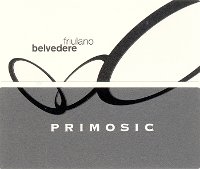
|
|
Collio Friulano Belvedere 2007 |
|
| Primosic (Friuli Venezia Giulia, Italy) | |
| Grapes: Friulano | |
| Price: € 18.00 | Score: |
| Collio Friulano Belvedere shows a greenish yellow color and nuances of greenish yellow, very transparent. The nose reveals intense, clean, pleasing and refined aromas that start with hints of pear, peach and pineapple followed by aromas of broom, hawthorn, almond and apple. The mouth has good correspondence to the nose, a crisp attack and however balanced by alcohol, good body, intense flavors. The finish is persistent with flavors of apple, peach and pineapple. Collio Friulano Belvedere ages in steel tanks. | |
| Food Match: Vegetable soups, Pasta and risotto with fish and crustaceans, Sauteed fish | |
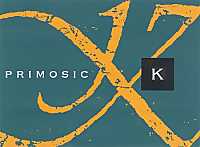
|
|
Collio Bianco Klin 2004 |
|
| Primosic (Friuli Venezia Giulia, Italy) | |
| Grapes: Sauvignon Blanc (40%), Chardonnay (30%), Ribolla Gialla (25%), Picolit (5%) | |
| Price: € 33.00 | Score: |
| Collio Bianco Klin shows a brilliant straw yellow color and nuances of straw yellow, very transparent. The nose reveals intense, clean, pleasing, refined and elegant aromas that start with hints of apple, plum and pear followed by aromas of pineapple, vanilla, banana, hawthorn, citrus fruits, almond, peach and grapefruit. The mouth has good correspondence to the nose, a crisp attack and pleasing roundness, however balanced by alcohol, good body, intense flavors. The finish is persistent with flavors of apple, pineapple and banana. A well made wine. Collio Bianco Klin ages for 18 months in cask, 6 months in steel tanks and 12 months in bottle. | |
| Food Match: Stuffed pasta, Roasted fish, Roasted white meat, Mushroom soups | |
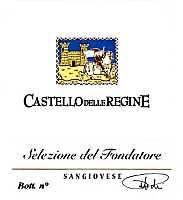
|
|
Selezione del Fondatore 2002 |
|
| Castello delle Regine (Umbria, Italy) | |
| Grapes: Sangiovese Grosso | |
| Price: € 23.00 | Score: |
| Selezione del Fondatore shows an intense ruby red color and nuances of garnet red, little transparency. The nose reveals intense, clean, pleasing and refined aromas that start with hints of plum, black cherry and blueberry followed by aromas of dried violet, vanilla, tobacco, coffee, chocolate, mace and eucalyptus. The mouth has good correspondence to the nose, good body, intense flavors, pleasing roundness. The finish is persistent with flavors of plum, black cherry and blueberry. Selezione del Fondatore ages for 14 months in barrique followed by at least 36 months of aging in bottle. | |
| Food Match: Broiled meat and barbecue, Roasted meat, Braised and stewed meat, Hard cheese | |
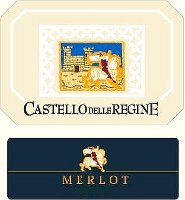
|
|
Merlot 2004 |
|
| Castello delle Regine (Umbria, Italy) | |
| Grapes: Merlot | |
| Price: € 32.00 | Score: |
| This Merlot shows an intense ruby red color and nuances of ruby red, little transparency. The nose reveals intense, clean, pleasing, refined and elegant aromas which start with hints of black currant, black cherry and plum followed by aromas of violet, blueberry, vanilla, tobacco, chocolate, cinchona, coffee, mace and eucalyptus. The mouth has excellent correspondence to the nose, a tannic attack and pleasing roundness, however balanced by alcohol, full body, intense flavors, agreeable. The finish is very persistent with long flavors of black currant, plum and black cherry. A well made wine. This Merlot ages for 12 months in barrique followed by 24 months of aging in bottle. | |
| Food Match: Game, Stewed and braised meat, Roasted meat, Hard cheese | |
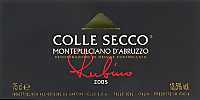
|
|
Montepulciano d'Abruzzo Colle Secco Rubino 2005 |
|
| Cantina Tollo (Abruzzo, Italy) | |
| Grapes: Montepulciano | |
| Price: € 4.50 | Score: |
| Montepulciano d'Abruzzo Colle Secco Rubino shows an intense ruby red color and nuances of ruby red, little transparency. The nose denotes intense, clean, pleasing and refined aromas which start with hints of plum, black cherry and violet followed by aromas of blueberry, vanilla, carob, mace and menthol. The mouth has good correspondence to the nose, a tannic attack and however balanced by alcohol, good body, intense flavors. The finish is persistent with flavors of black cherry, plum and blueberry. Montepulciano d'Abruzzo Colle Secco Rubino ages for 24 months in cask. | |
| Food Match: Stuffed pasta with meat, Roasted meat, Stewed meat with mushrooms | |
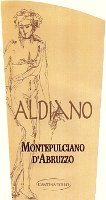
|
|
Montepulciano d'Abruzzo Aldiano 2006 |
|
| Cantina Tollo (Abruzzo, Italy) | |
| Grapes: Montepulciano | |
| Price: € 9.50 | Score: |
| Montepulciano d'Abruzzo Aldiano shows a deep ruby red color and nuanced of ruby red, little transparency. The nose reveals intense, clean, pleasing and refined aromas that start with hints of black cherry, blueberry and violet followed by aromas of plum, blackberry, vanilla, cocoa, tobacco, pink pepper and menthol. The mouth has good correspondence to the nose, a tannic attack and however balanced by alcohol, good body, intense flavors. The finish is persistent with flavors of black cherry, plum and blueberry. Montepulciano d'Abruzzo Aldiano ages for 12 months in cask followed by 6 months of aging in bottle. | |
| Food Match: Roasted meat, Stewed and braised meat with mushrooms, Hard cheese | |
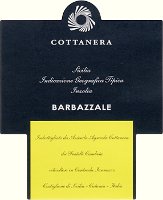
|
|
Barbazzale Bianco 2007 |
|
| Cottanera (Sicily, Italy) | |
| Grapes: Inzolia | |
| Price: € 8.00 | Score: |
| Barbazzale Bianco shows an intense greenish yellow color and nuances of greenish yellow, very transparent. The nose denotes intense, clean and pleasing aromas which start with hints of pear, peach and pineapple followed by aromas of hawthorn, citrus fruits, almond and plum. The mouth has good correspondence to the nose, a crisp attack and however balanced by alcohol, good body, intense flavors. The finish is persistent with flavors of apple, peach and almond. Barbazzale Bianco ages for 6 months in steel tanks. | |
| Food Match: Fried fish, Pasta and risotto with crustaceans and fish, Sauteed fish | |
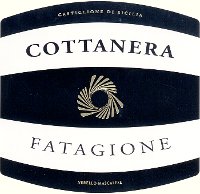
|
|
Fatagione 2006 |
|
| Cottanera (Sicily, Italy) | |
| Grapes: Nerello Mascalese (85%), Other Grapes (15%) | |
| Price: € 16.00 | Score: |
| Fatagione shows a brilliant ruby red color and nuances of ruby red, moderate transparency. The nose denotes intense, clean, pleasing and refined aromas which start with hints of cherry, plum and blackberry followed by aromas of blueberry, violet, vanilla, carob, tobacco and mace. The mouth has good correspondence to the nose, a tannic attack and however balanced by alcohol, good body, intense flavors. The finish is persistent with flavors of cherry, plum and blackberry. Fatagione ages for 12 months in cask. | |
| Food Match: Stuffed pasta with meat, Stewed meat with mushrooms, Broiled meat and barbecue | |
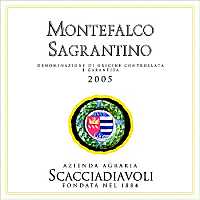
|
|
Sagrantino di Montefalco 2005 |
|
| Scacciadiavoli (Umbria, Italy) | |
| Grapes: Sagrantino | |
| Price: € 25.00 | Score: |
| This Sagrantino di Montefalco shows an intense ruby red color and nuances of ruby red, little transparency. The nose denotes intense, clean, pleasing and refined aromas which start with hints of black cherry, plum and blackberry followed by aromas of violet, blueberry, vanilla, tobacco, pink pepper, cocoa and eucalyptus. The mouth has good correspondence to the nose, a tannic attack and however balanced by alcohol, full body, intense flavors. The finish is persistent with flavors of black cherry, blackberry and plum. This Sagrantino di Montefalco ages for 15 months in barrique followed by at least 9 months of aging in bottle. | |
| Food Match: Game, Roasted meat, Braised and stewed meat, Hard cheese | |
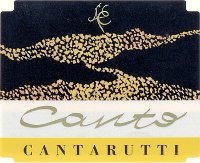
|
|
Colli Orientali del Friuli Bianco Canto 2007 |
|
| Cantarutti Alfieri (Friuli Venezia Giulia, Italy) | |
| Grapes: Tocai Friulano (50%), Pinot Blanc (25%), Sauvignon Blanc (25%) | |
| Price: € 7.20 | Score: |
| Colli Orientali del Friuli Bianco Canto shows an intense golden yellow color and nuances of straw yellow, very transparent. The nose denotes intense, clean, pleasing and refined aromas which start with hints of apple, pear and peach followed by aromas of pineapple, citrus fruits, medlar, broom, almond, litchi and plum. The mouth has good correspondence to the nose, a crisp attack and pleasing roundness, however balanced by alcohol, good body, intense flavors. The finish is persistent with flavors of apple, peach and almond. Colli Orientali del Friuli Bianco Canto ages in steel tanks. | |
| Food Match: Stuffed pasta, Sauteed white meat, Stewed fish, Mushroom soups | |

|
|
Colli Orientali del Friuli Rosso Poema 2001 |
|
| Cantarutti Alfieri (Friuli Venezia Giulia, Italy) | |
| Grapes: Merlot (70%), Cabernet Sauvignon (20%), Cabernet Franc (10%) | |
| Price: € 11.40 | Score: |
| Colli Orientali del Friuli Rosso Poema shows an intense ruby red color and nuances of garnet red, little transparency. The nose reveals intense, clean, pleasing and refined aromas that start with hints of black cherry, black currant and plum followed by aromas of violet, vanilla, chocolate, tobacco, cinnamon, clover, leather and menthol. The mouth has good correspondence to the nose, a tannic attack and however balanced by alcohol, good body, intense flavors, pleasing roundness. The finish is persistent with flavors of plum, black currant and black cherry. Colli Orientali del Friuli Rosso Poema ages for 18 months in barrique. | |
| Food Match: Roasted meat, Braised and stewed meat, Hard cheese | |
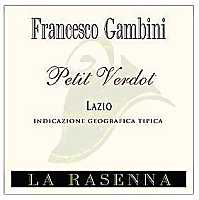
|
|
Petit Verdot 2007 |
|
| La Rasenna (Latium, Italy) | |
| Grapes: Petit Verdot | |
| Price: € 8.00 | Score: |
| This wine shows an intense ruby red color and nuances of ruby red, little transparency. The nose denotes intense, clean, pleasing and refined aromas which start with hints of black cherry, plum and black currant followed by aromas of blackberry, violet, blueberry, tobacco and carob. The mouth has good correspondence to the nose, a tannic attack and however balanced by alcohol, good body, intense flavors. The finish is persistent with flavors of plum, black cherry and black currant. A small part of this Petit Verdot ages in cask. | |
| Food Match: Broiled meat and barbecue, Stewed meat with mushrooms, Hard cheese | |
News |
|
In this section are published news and information about events concerning the world of wine and food. Whoever is interested in publishing this kind of information can send us a mail to our address.
|
AquavitaeReview of Grappa, Distillates and Brandy |
|
|
| Distillates are rated according to DiWineTaste's evaluation method. Please see score legend in the "Wines of the Month" section. |
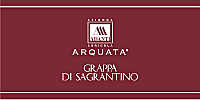
|
|
Grappa di Sagrantino |
|
| Adanti (Umbria, Italy) | |
| (Distiller: Distillerie Aquileia) | |
| Raw matter: Pomace of Sagrantino | |
| Price: € 20.00 - 500ml | Score: |
| This grappa is colorless, limpid and crystalline. The nose denotes intense, clean and pleasing aromas of hazelnut, blackberry, black cherry, plum and licorice, with almost imperceptible alcohol pungency. In the mouth has intense flavors with alcohol pungency which tends to dissolve rapidly, good roundness, perceptible sweetness. The finish is persistent with flavors of black cherry, blackberry and licorice. This grappa is produced with discontinuous steam operated alembic still. Alcohol 46%. | |
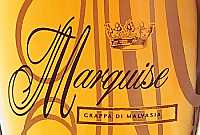
|
|
Grappa Stravecchia di Malvasia 10 Anni Marquise |
|
| Casa Luparia (Piedmont, Italy) | |
| Raw matter: Pomace of Malvasia | |
| Price: € 100.00 - 70cl | Score: |
| This grappa shows a pale amber yellow color, crystalline. The nose reveals intense, clean, pleasing, refined and elegant aromas of candied fruits, raisin, vanilla, hazelnut, date, dried fig, dried apricot, honey and tobacco, with imperceptible alcohol pungency. In the mouth has intense flavors, perceptible alcohol pungency which tends to dissolve rapidly, pleasing roundness, balanced sweetness. The finish is very persistent with long flavors of raisin, candied fruits, dried apricot and hazelnut. A well made grappa produced with a discontinuous alembic still operating at low pressure. It ages for 10 years in oak casks. Alcohol 42%. | |
Wine Parade |
|
|
| The best 15 wines according to DiWineTaste's readers. To express your best three wines send us an E-mail or fill in the form available at our WEB site. |
| Rank | Wine, Producer | |
|---|---|---|
| 1 |
| Blanc des Rosis 2006, Schiopetto (Italy) |
| 2 |
| Sforzato di Valtellina San Domenico 2002, Triacca (Italy) |
| 3 |
| Chianti Classico Riserva Novecento 2000, Dievole (Italy) |
| 4 |
| Aglianico del Vulture La Firma 2004, Cantine del Notaio (Italy) |
| 5 |
| San Leonardo 2001, Tenuta San Leonardo (Italy) |
| 6 |
| Bradisismo 2003, Inama (Italy) |
| 7 |
| Sangiovese di Romagna Superiore Riserva Thea 2005, Tre Monti (Italy) |
| 8 |
| Wine Obsession 2001, Vignamaggio (Italy) |
| 9 |
| Sagrantino di Montefalco Collepiano 2003, Arnaldo Caprai (Italy) |
| 10 |
| Moscato d'Asti 2007, Vignaioli di S. Stefano (Italy) |
| 11 |
| Barolo Bussia 2001, Prunotto (Italy) |
| 12 |
| Villa Gresti 2004, Tenuta San Leonardo (Italy) |
| 13 |
| Arkezia Muffo di San Sisto 2004, Fazi Battaglia (Italy) |
| 14 |
| Collio Bianco Col Disôre 2004, Russiz Superiore (Italy) |
| 15 |
| Moscato d'Asti 2007, Vignaioli di S. Stefano (Italy) |
| |||||||
Privacy Policy | |||||||


| Copyright © 2002-2024 Antonello Biancalana, DiWineTaste - All rights reserved |
| All rights reserved under international copyright conventions. No part of this publication and of this WEB site may be
reproduced or utilized in any form or by any means, electronic or mechanical, without permission in writing from DiWineTaste. |